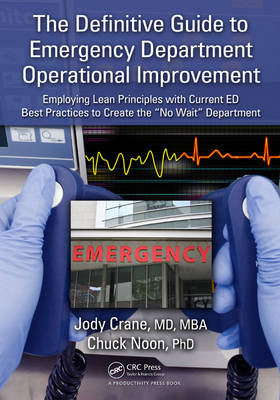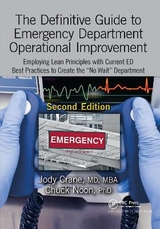
The Definitive Guide to Emergency Department Operational Improvement
Productivity Press (Verlag)
978-1-4398-0840-5 (ISBN)
- Titel erscheint in neuer Auflage
- Artikel merken
After summarizing the current state of emergency medicine, the book offers an in-depth presentation of Lean tools used in the ED along with basic and advanced flow principles grounded in queuing theory and the theory of constraints. It then shows how these concepts are applied in the emergency department and why they work, supported by a comprehensive case study in which Lean principles were used to transform an underperforming ED into a world-class operation.
The authors highlight three commonly referenced intervals in the ED: door to doc (input), doc to disposition (throughput), and disposition to departure (output). After reviewing best practices, the authors explain how to achieve excellence in your own environment by discussing change management, leadership, dealing with resistance, and other critical elements of creating a culture of change. Under any scenario realized by healthcare reform, this book provides the tools and concepts to improve your ED for patients, staff, the organization, and ultimately, society.
About the Authors: Joseph T. Crane, MD, MBA is one of the nation’s leading experts in emergency department (ED) operations. He is an emergency physician practicing at Mary Washington Hospital in Fredericksburg, Virginia. In addition to his clinical responsibilities, from 2002 to 2009, he served as the business director of his group, Fredericksburg Emergency Medical Alliance. In 2004, he graduated from the Physician Executive MBA Program (PEMBA) at the University of Tennessee, where he is currently an adjunct professor teaching physician-led operations improvement. Dr. Crane’s work focuses on innovative approaches to ED and hospital-wide operational and patient flow improvement, specifically addressing the application of Lean manufacturing concepts within the healthcare environment. He also specializes in leadership and change management for operational and clinical improvement. Dr. Crane is an emergency medicine faculty member of The Institute for Healthcare Improvement. His company, X32 Healthcare, teaches and consults with organizations on process improvement using Lean applications. Through these engagements, Dr. Crane has worked with hundreds of EDs from around the world on adopting innovations in the delivery of emergency care. He has taught and worked in a wide variety of settings in the United States, Canada, Europe, South America, and the Middle East, including courses or sessions at The University of Tennessee, The University of Kansas, George Mason University, and Harvard University. Charles E. Noon, PhD is a professor of management science in the College of Business at the University of Tennessee. He is a founding member of the highly ranked Physician Executive MBA Program and continues to teach in the program. He holds a PhD in industrial and operations engineering from the University of Michigan. His teaching interests include operational improvement, business modeling, simulation, and decision analysis and support. His applied research concerns computer-based models and process improvement, and his papers in these areas have appeared in Interfaces, Journal of Healthcare Management, and Networks and Spatial Analysis. Dr. Noon also teaches in the full-time MBA program, the Management Science PhD program, and various nondegree executive education programs, including a new offering entitled Lean for Healthcare. He is the recipient of numerous teaching awards and serves as a teaching mentor for junior faculty. To stay current, he periodically consults with hospitals on process improvement, capacity planning, and staff scheduling.
The Current State of Emergency Medicine and the Need for a New Operations Paradigm
ED Overcrowding
Danger Waiting
Hospital-wide Flow
US Healthcare System
The Need for Change
Part I: Academic Topics Critical to Understanding ED Operations
Lean Healthcare
Introduction and History of Lean
Patient Value
Service Families and Value Streams
Value Stream Mapping
MUDA
Seeing waste from the patient’s perspective
7 wastes
Lean Tools Critical for ED Operations
Workplace Organization/5S
Visual Workplace
Standard Work
Mistake-proofing
Inventory and Supply Management
Flow in Healthcare Systems
Flow in Healthcare Settings
Queuing Theory
Background
The Simple Queue
Arrival Rate
Arrival Distribution
Poisson Distribution Pattern
Service Rate
Service Distribution
The Effect of Variation in Healthcare
The Effect of Server Utilization in Service Industries with Diverse Variation Patterns
Achieving Lean Flow
The Approach to Reducing Flow Times through Queues
Reducing Arrival Rate
Reducing Variation in Arrivals
Reducing Service Times
Reducing Variation in Service Times
Adding Capacity
Using Data and Simulation to Solve Complex Queuing Problems in Healthcare
Examples of Applied Queuing in ED Settings
Healthcare as a Network of Queues
Patient’s Perspective
Server’s Perspective
Conservation of Flow
Volunteer Walk-in Clinic
Approach to Reducing Waiting Through a Network of Queues
Lean Design in Queuing Networks
Principle 1: Reduce the Number of Queues
Combining Steps
Concurrency
One-Piece Flow
Principle 2: Pooling
Principle 3: Pull Systems
Principle 4: Segmentation
Reduction of Service Times
Reduction of Variation
Radically Different Segments
The Psychology of Waiting
Part II: A Step-by-Step Guide to Fixing Your Emergency Department
Defining key Intervals in Emergency Operations
Door to Doc
Reception
Registration
Triage
ESI
Chief Complaint Based, Directed
Bed Placement
Patient Segmentation
Doc to Decision
Initial RN Evaluation and Assessment
Initial MD Evaluation
Ancillary Services
Patient-specific In-ED Treatment
The Relationship between Service Capacity in the ED
Load Leveling
MD, RN, Bed, Ancillary Balancing
Virtual Beds
Decision to Departure
Decision to Admit to Bed Assignment
Inpatient Utilization as a Function of ED Holds
The difference between Staffed Capacity and Licensed Capacity
Forecasting Demand
Surgical Smoothing
Finding Critical Inpatient Capacity
The Value of Patient Flow Teams
Bed Assignment to Departure
Hospitalists
Calling Report – The Games People Play
The Effect of Incentives on Throughput
Faxed Reports
Full Capacity Protocol
Making Change Happen
Leadership
Change Management
Picking the Right Project
Picking the Right Team
Define Current Process
Analyze the Data
Listen to Patients
Improve Process
Define Future Process
Rapid Cycle Testing
Implementation
Dealing with Resistance
Management
Case Studies in ED Improvement
Mary Washington Hospital
Ochsner Health System
Banner Health
Florida Hospital
IHI
Appendix
Glossary
Index
| Erscheint lt. Verlag | 24.4.2011 |
|---|---|
| Zusatzinfo | N/A; N/A; 16 Tables, black and white; 262 Illustrations, black and white |
| Verlagsort | Portland |
| Sprache | englisch |
| Maße | 178 x 254 mm |
| Gewicht | 612 g |
| Themenwelt | Medizin / Pharmazie ► Gesundheitswesen |
| Medizin / Pharmazie ► Medizinische Fachgebiete ► Notfallmedizin | |
| Wirtschaft ► Betriebswirtschaft / Management ► Unternehmensführung / Management | |
| ISBN-10 | 1-4398-0840-6 / 1439808406 |
| ISBN-13 | 978-1-4398-0840-5 / 9781439808405 |
| Zustand | Neuware |
| Haben Sie eine Frage zum Produkt? |
aus dem Bereich



